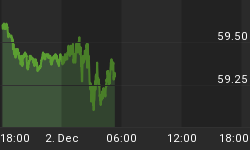Below is a chart showing the daily number of our unweighted S&P 500 stocks that are showing Negative Strength.
If you are analyzing the market, you really want the added advantage of seeing what the trending would look like if you looked at the S&P 500 on an unweighted basis.
Why is that important?
Below is a list of the top 10 stocks on the S&P 500 as of the close on Thursday:
*Apple Inc. *Exxon Mobil Corp. *International Business Machines Corp. *Microsoft Corp. *Chevron *Johnson & Johnson *Procter & Gamble *AT&T Inc. *General Electric Co. *Coca-Cola
These 10 stocks out of 500 represents 2% of the total number of stocks. And yet, because the S&P is a market capitalization weighted index ... this 2% of the S&P's stocks represents 20.39% of the index on a Market cap per share basis. (Some argue that a market cap weighted index gives one a skewed picture of what is really going on.)
What? 10 stocks reflect 20% of the whole index's movement?
What would the picture look like if its stocks were equally weighted?
So today, we will look at all the stocks on the S&P 500 as if they were equally weighted, and then measure their individual strengths. Specifically, we will show you a count of unweighted S&P stocks with Negative strength. Since the market has been going down, many professional investors want to know what is happening to the stocks that are going down on "an unweighted group" basis.
This first chart show's the total daily number of S&P 500 stocks with negative strength since Sept. 9th.
Notice how you can see the number of Negative Stocks declining from September 9th. to September 16th. And then ... note how the number of Negative Stocks INCREASED from September 19th. to the 22nd. (September 17 and 18 were weekend days with the market closed.)
Now, if you look at your actual S&P 500 stock market charts, you will see that the S&P went up from September 12 to the 16th, and then down from September 19 to the 22nd. Excellent correlation.
But ... there is one more significant fact that should not be overlooked ... see the second chart ...

Below is the second chart ... actually, it is the same chart EXCEPT that we expressed the number of Negative Strength stocks per day in terms "of their percentage of the total number of stocks being measured".
Since it is the S&P 500, the total number of stocks is 500 and we just divide the Negative amount by 500 to get the daily percentages as seen below.
Hopefully, something BIG hits you at this point.
What is it? It is the fact that the percentage of Negative stocks on September 9th. was 86%, and the number of Negative stocks on September 22nd. (yesterday) was 87%.
Here is what you should observe ... For the percentage to reach 100%, EVERY SINGLE STOCK on the S&P 500 would have to be going down, which would mean that 100% of the stocks were being sold.
So, what happens before that? We reach a percentage where too many stocks of real positive value are going down (increasing in Negative Strength) ... and that is when the market reaches an "oversold condition". That oversold condition starts when the percentage of stocks growing in Negative Strength reaches 80% or higher. Since investors can't resist true bargains being left on the table, they come in and start buying the undervalued stocks. (These kind of charts and stock market measurements are posted every day on our Standard subscriber site.)

















